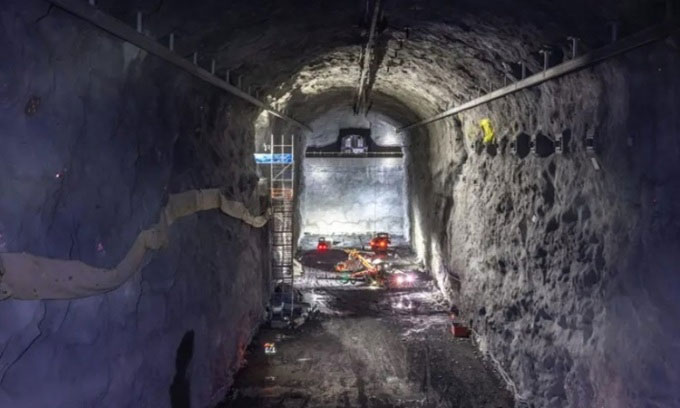Ghost particle detector at a depth of 1,600m
The research team at Fermilab will observe ghost particles traveling 1,287 km between detectors, thereby uncovering the mysteries of the universe.
Nearly seven years ago, crews began digging 800,000 tons of rock out of an old gold mine near Lead, South Dakota. The resulting underground cave is 152.4 meters long and tall enough to accommodate a 7-story building. Estimated to cost at least $3 billion, the DUNE (Deep Underground Neutrino Experiment) project is led by scientists at the US Department of Energy's Fermilab laboratory. Each cave will contain 17,500 tons of liquid argon to help physicists at Fermilab detect neutrinos, also known as ghost particles, according to Business Insider .

One of the caves containing the ghost particle detector in the DUNE project. (Photo: Matthew Kapust)
Neutrinos are subatomic particles that surround humans and can pass through them undetected. "If you hold your hand, 10 billion neutrinos from the Sun pass through your hand every second ," said physicist Mary Bishai, a spokeswoman for the DUNE project.
Neutrinos are nicknamed ghost particles because they have no electrical charge and therefore rarely interact with anything they come into contact with. This makes neutrinos extremely difficult to study. However, scientists persist because neutrinos can play a key role in helping to decode many of the mysteries of the universe, from what happened after the Big Bang to observing the birth of black holes. Studying a particle that does not emit radiation and is lighter than an electron is a challenge, according to Bishai.
The team of experts at Fermilab wanted to study neutrinos in unprecedented detail with DUNE. That's why DUNE will have the largest neutrino detectors ever built. Once completed, the experiment will begin with a series of particle accelerators at Fermilab's facility outside Chicago, Illinois. The accelerators will shoot a powerful beam of neutrinos through detectors at Fermilab. The particle beam will then travel underground 1,287 km to the detector at the Sanford South Dakota Underground Research Facility.
There are three types of neutrinos, and particles can switch between them in a phenomenon called oscillation . A scientist at Fermilab once compared the phenomenon to a house cat transforming into a jaguar, then a tiger before returning to its original form. Tracking how neutrinos change over such long distances between Illinois and South Dakota will help scientists better understand the oscillations. Conducting the experiment at a depth of 1.6 km underground protects the fragile vibrating particles from the energetic cosmic rays that continuously bounce off the Earth's surface every second, threatening to affect the data.
Scientists hope to answer three main questions with DUNE: Why is the universe made of matter instead of antimatter, what happens when a star collapses, and do protons decay? DUNE's particle beam is designed to produce both neutrinos and antineutrinos. Observing fluctuations in each type can help researchers guess what happens to all antimatter.
The project also serves supernova physics , according to Bishai. In 1987, astronomers witnessed the closest extremely bright supernova explosion in 400 years. With the detectors available at the time, they could only detect more than two dozen neutrinos. There's a 40 percent chance of another nearby star exploding in the next decade, and Fermilab hopes at least one of the detectors in South Dakota will be operational in time. A detector that large could collect thousands of neutrinos, revealing how black holes and neutron stars form.
Ultimately, scientists have yet to see the proton decay, but there are theories that predict it. Protons are extremely small positively charged particles, located in the nucleus of an atom. If the proton decays, the process will take an extremely long time. But neutrino detectors can look for different signs of proton decay.
Currently, there are several neutrino projects around the world, including the Japan Proton Acceleration Research Consortium (J-PARC) and the European Agency for Nuclear Research (CERN). What makes DUNE unique is the use of argon and the long distance between the detectors.
Due to budget and schedule issues, the DUNE project was designed with four argon detectors but will begin operations with two. The first detector will be operational by the end of 2028 and the second detector will begin operations a year later. They will work in the event of a supernova, but by 2031 the beam will be ready. The project is the result of collaboration between 1,400 people from 36 countries.
- China built a 'ghost particle' detector at a depth of 700m
- The LHC finds legendary beads
- The world's largest experiment on Neutrinos
- Discovering the 'ghost particle' - A strange form of life outside the universe
- NASA revealed the mysteries in the sun
- China wants to build a particle accelerator twice as large as the LHC
- The 'ghost' fish only lives at a depth of 7.5 km on the seabed, melting when ashore
- Pentaquark - newly discovered atomic particles
- Discover the idea of building a particle accelerator on the Moon
- Ghost sharks were first recorded at a depth of 2,000m
- Successfully built the world's thinnest X-ray detector
- Inside the CIA lie detector
 Norway built the world's tallest wooden tower
Norway built the world's tallest wooden tower Kremlin
Kremlin Ashurbanipal: The oldest royal library in the world
Ashurbanipal: The oldest royal library in the world Decoding the thousand-year construction of Qin Shihuang shocked the world
Decoding the thousand-year construction of Qin Shihuang shocked the world